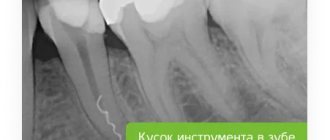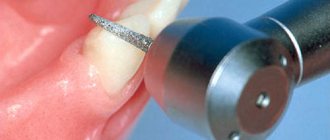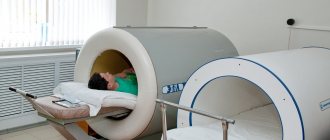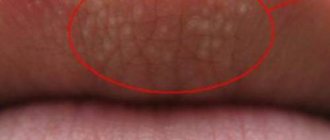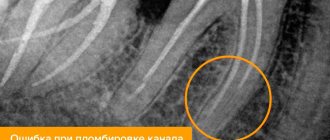The most popular prosthesis for missing teeth is a dental bridge. In addition to the aesthetic effect, it contributes to the physiological distribution of chewing forces - occlusal loads are partially transferred to the alveolar process, due to which atrophy occurs much more slowly than in people who use removable dentures or leave “gaps” in the row without restoration.
Reconstruction of missing teeth using bridges is possible when the patient has his own teeth that are used as support. A dental bridge restores the aesthetic shape, color, symmetry of the dental arches, as well as chewing function. Prosthetic structures are developed individually for each patient and can be made from various materials, in accordance with the indications, aesthetic expectations and budget of the patients.
Dental prosthesis made of metal-ceramics - features, types, pros and cons, prices
Article navigation
- Metal-ceramic bridge
- Design advantages
- Varieties
- Manufacturers
- Indications and contraindications
- Disadvantages and complications
- Manufacturing
- How to install and remove the structure
- Warranty and service life
- Rules for wearing and care
- Repair features
- What is better to put
- Price
question for a specialist
Several decades ago, “gold” and “iron” bridges gave way to their leading positions to another design - aesthetic and durable. We are familiar with it under the name “metal-ceramic bridge”. In today’s material, we will reveal the most important characteristics of a dental bridge made of metal ceramics – what the structure looks like, its pros and cons, how it is placed and how it is removed from the teeth. We will also dwell on other, no less interesting questions on the topic.
Advantages and disadvantages of dental plastic crowns – expert opinions of doctors
The advantages of plastic construction include the following points:
- the simplest restoration of tooth function;
- relatively low price for “new teeth”;
- aesthetics of the product, because installing such a crown is always better than leaving a gap in the cavity;
- the ability to choose the required crown based on the shade and shape of the tooth;
- they are quickly produced (even in front of the patient).
The nuances of using temporary plastic crowns include:
- short service life - from several months to a year;
- fragility of the material, especially when taking solid products;
- crowns are not as transparent as ceramic ones;
- Over time, such artificial teeth darken and absorb pigments, because plastic has a porous texture;
- over time, a gap forms between the lined part and the frame, where bacteria accumulate;
- The plastic material wears out quickly;
- the edges of the crown may put pressure on the gums, and additional soft tissue treatment may be necessary;
- abutment teeth can be pre-ground;
- plastic can cause allergies.
What is a metal-ceramic bridge?
A dental bridge made of metal-ceramics is a non-removable permanent prosthesis consisting of several metal-ceramic crowns, combined with each other at the manufacturing stage. Intermediate crowns (solid) replace missing teeth, and extreme crowns (hollow inside) are placed on supports (living teeth or their roots, on implants). The base or frame of the bridge consists of a metal alloy - with cobalt, nickel, chromium, less often with titanium or with precious metals (platinum, gold, palladium, silver). On top of the metal is lined with porcelain - a ceramic mass with a hint of natural enamel. You can see in the photo how your smile changes before and after the installation of this orthopedic structure.
What is the maximum number of teeth that can be placed?
The length of the bridge is affected by the extent of the defect. Taking into account the supports, the device will contain more crowns than missing units of the dentition. When performing prosthetic bridges, orthopedists are guided by the rule that the design should not be dominated by intermediate crowns. That is, the number of the latter must be equal to or less than the number of support units. For example, a prosthesis for 1 tooth will consist of 3 crowns, and for 2 teeth - 4-5.
The length of the bridge depends on the location and extent of the defect
Bridge prosthetics for 3 teeth requires grinding of 5-6 units. This is due to the peculiarities of load distribution from the intermediate crowns between the supports. Dentists recommend installing bridges if 1-2 units are missing. For extended defects, more supports are required. Accordingly, more living teeth will suffer.
The location of the defect also influences the possibilities of prosthetics. It is important to ensure that the supports and intermediate crowns are located on the same line. When installing a bridge at a bend in a row, it is impossible to comply with this requirement. The load will not be distributed correctly between the supports. The 4-tooth design requires 4-6 units of grinding and will be installed on a bend. Sooner or later, under the influence of chewing loads, such a prosthesis will break.
In case of multiple row defects (5 teeth or more), it is not advisable to install a bridge between the teeth, due to the high risk of structural failure and accelerated destruction of the supports.
What are the advantages of the design?
Metal-ceramic dental bridges have important advantages, due to which they are chosen by the vast majority of orthopedic dentists’ patients. Let's take a closer look at the positive characteristics:
- high aesthetics combined with a relatively low cost: this is the main advantage of a metal-ceramic bridge, which often becomes the “factor of choice” for the patient,
- fast production,
- Possibility of installation on both natural teeth and dental implants,
- quick adaptation and easy care.
Only until December 25 South Korean implant Osstem - from 18,500 rubles.
Hurry up to sign up for a free consultation and lock in promotional prices.
Call now or request a call
Opening hours: 24 hours a day - seven days a week
Types of bridge structures
Metal-ceramic bridges are only permanent (there are no temporary ones). These are permanent structures, i.e. The dentist fixes them, but the patient cannot (and should not) remove them. Crowns are usually attached to special cement, and when installed on implants, they can be fixed with small screws.
For a traditional bridge (metal-ceramic or any other), at least 1 abutment tooth is required on both sides of the empty space. But there are also cantilever bridges, which are fixed on 1-2 supports only on one side of the empty area. However, they often cause dislocation of the supporting tooth, so they are not recommended for installation. Adhesive prostheses, known as Maryland (Bonded) Bridge, are not made from metal ceramics.
There are also 2 methods of processing the lower part of supporting metal-ceramic crowns. In the classic version, a thin strip of metal remains under the gum, not covered with ceramics. But there is an even more “advanced” option - crowns on the shoulder mass, when the edges of the crowns in the area of contact with the gum and tooth stump are covered with a layer of ceramics. This eliminates the risk of allergies and does not cause “blueness” of the gums.
Metal-ceramic teeth. How has the material proven itself?
Metal-ceramic dentures are a crown or bridge on a metal frame coated with ceramic. The orthodontic design is identical to the shape of a real tooth, so the prosthesis is easily installed in the jaw and does not cause discomfort to the patient while wearing it. According to statistics, metal-ceramic implants are much less likely than other prostheses to cause an allergic reaction. Most often, specialists at the A-Medic clinic use ceramic prostheses to restore teeth in the chewing region. The material has proven itself optimally not only from an aesthetic, but also from a practical point of view. The main advantages of metal-ceramic prostheses are:
- reliability;
- functionality;
- aesthetic indicators;
- ease of installation;
- affordable price for most patients.
Thanks to the unique properties of ceramics, the dentist has the opportunity to select a prosthesis whose shade best matches the color of the client’s own teeth. Provided that it is installed properly, a ceramic-coated implant is invisible in the mouth and therefore does not cause psychological discomfort to a person.
High-quality veneering ceramics – manufacturers
Today, there are many manufacturers of ceramic masses for lining metal prosthetic frames. Let's look at those brands that have been delivering high-quality products for a long time:
- IPS Classic, IPS d.SIGN and IPS Style from Ivoclar Vivadent: the manufacturer offers a wide range of ceramic compounds for application to metal - these are classic compounds and modern ones with fluorapatite (glass ceramics) and oxyapatite. Allows you to create restorations that are indistinguishable from natural teeth,
- Super Porcelain EX-3 from Kuraray Noritake: the material conveys almost natural translucency and shade transitions from the cutting edge of the crowns to the base,
- Duceram plus and Duceram kiss from Dentsply Sirona: easy-to-use and versatile formulations with excellent aesthetics and high strength,
- VMK Master from VITA Zahnfabrik: universal material for frames made of base and precious metals, shrinks minimally during manufacturing.
Indications and contraindications
The indication for the installation of a classic metal-ceramic bridge is the absence of 1 or several teeth in a row (but no more than 4 adjacent ones). Moreover, 2-4 healthy teeth or roots should be preserved along the edges, which will be used for supports. If there are 1 or several teeth missing at the end of the row, then it is better to install not a console, but a bridge on implants.
Contraindications to metal-ceramic bridge prosthetics are as follows:
- end defects (no tooth at the end of the row) for classical designs,
- absence of 5 or more teeth in a row,
- inflammatory processes in the oral cavity,
- mobile, diseased or collapsing supports that cannot be cured or strengthened with a pin/stump,
- the presence of cysts or granulomas under the roots,
- the supports are too low: ideally the height of the stump should be 5 mm or more,
- allergy to materials,
- intolerance to anesthesia: preparation for prosthetics includes depulping supports or installing implants, and this cannot be done without an anesthetic injection,
- exacerbation or late stages of periodontitis/periodontal disease,
- the presence in the mouth of dentures with inclusions of other metals: this way, an electrical impulse will arise between the old and new dentures - galvanism,
- inability to carry out proper oral hygiene.
Caution: Galvanic Syndrome
It is worth mentioning separately about the so-called galvanic syndrome - the body’s reaction to the presence of metal prostheses in the mouth. These can be not only dental bridges, but also individual crowns, orthodontic appliances, inlays and even fillings with amalgam.
When interacting with saliva, which acts as an electrolyte, a potential difference occurs in the metal with the formation of galvanic currents. This complication manifests itself as a metallic taste in the mouth, dryness, burning, headaches, and sleep disturbances. The dentures themselves may darken.
The development of galvanism requires the resumption of orthopedic treatment with the replacement of a dental bridge made of a more inert metal or dental porcelain.
Important! Factors of increased risk of galvanism are initial defects in dentures, mechanical damage during operation of bridges, changes in the acid-base environment in the mouth to the acidic side due to stomatitis, periodontitis and gastrointestinal pathologies.
After installing dental bridges, other unpleasant consequences are possible. The most important and difficult stage of treatment is the preliminary stage, when planning and choosing the type of dental bridge takes place.
Complications can be caused by:
- incompletely studied data on the patient’s health in general and the oral cavity in particular;
- incorrect interpretation of x-rays;
- insufficient x-ray studies;
- inattentive approach to customer complaints and wishes.
The listed shortcomings of the doctor are a serious mistake and often lead to serious complications after orthopedic treatment with the installation of dental bridges.
What is known about the disadvantages and complications after treatment
The disadvantages of a metal-ceramic dental bridge include a decrease in the aesthetics of the gums over time - this is especially noticeable on the front teeth. If simple metal-ceramic crowns are used (not with shoulder material), then due to constant contact with the metal, the gums become “bluish” in color. Also, the gums can peel off from the tooth and “go” up or down. In patients with a gummy smile - when part of the gum is exposed when smiling, this defect is most noticeable.
Therefore, it is recommended to install a classic metal-ceramic bridge on chewing teeth, and on the front teeth it is better to install ceramics without metal in the base. Or choose a metal-ceramic bridge on implants, but with the addition of a small section of acrylic gum.
Read on the topic: what is gingival contour correction during prosthetics and who may need this operation?
Another disadvantage of a bridge design based on your own teeth is that it does not protect against bone atrophy under the intermediate crowns. After all, the roots are no longer there, i.e. and the bone does not receive the same load - therefore, metabolic processes in this area stop, and the bone tissue decreases in size. Accordingly, the gums also recede, incl. near the supporting teeth. There is a risk of cervical caries. There is also a gap between the bridge and the gum, where food debris gets clogged and plaque accumulates. As a result, the bridge may begin to wobble or even fall out.
Metal-ceramic dental prosthetics
The technology has proven itself most actively in the restoration of chewing teeth, where not only aesthetics, but also strength are important. The widest range of ceramic coatings for dentures allows the material to imitate the structure of human dental tissue as accurately as possible.
Inexpensive metal-ceramics are used a little less frequently for the correction of front teeth, because the metal frame can be seen through the thin ceramic coating. That is why, for prosthetic treatment of front teeth, A-Medic dentists recommend that patients opt for ceramics based on zirconium. Essentially, this is the same metal-ceramics, which is based on white metal. Zirconium metal ceramics can be installed on any patient, even those prone to allergies, because the material is 100% biocompatible with the human body.
How is production carried out?
According to the manufacturing method, frames are of the following types:
- cast: created by casting,
- milled: manufactured using robotic CAD/CAM systems.
Most often, bases made of noble or base metals are created with a thickness of 0.5-0.3 mm. Thinner ones can be coated with a thicker layer of ceramic for better aesthetics. But before making a prosthesis, the patient first undergoes preparation, during which the supporting teeth are depulped and filled. Additionally, they can be strengthened with a pin or stump insert. This way the supports will be more stable under load and will last longer (provided that everything is done correctly). Then impressions are taken from the dentition.
Next, the impressions are sent to a dental laboratory, where a dental technician creates a model of the prosthesis1. A metal base is cast or milled using this model. After which it is covered with several layers of ceramics and then baked at high temperature. The result is a finished product that can be immediately installed on the patient. How long does it take to make a metal-ceramic bridge? Here, a lot depends on the quality of the impressions taken and the workload of the laboratory, but on average you will have to wait 1-2 weeks, and in the meantime you will have to wear a temporary prosthesis (it takes 1 day).
Price
- Primary appointment (examination, consultation) with a dentist (special offer) 100001
For free
Promotion
- Tooth restoration with a crown (E.max) 152013
21 900 ₽
- Tooth restoration with a full zirconium crown 152015
13 900 ₽
- Tooth restoration with an all-zirconium crown with ceramic lining 152016
21 900 ₽
- Tooth restoration with a metal-ceramic crown 152019
13 900 ₽
A bridge for 3 teeth is a non-removable orthopedic structure to restore the integrity of the dentition. When prosthetics are used, the anterior units are often made of solid ceramics, while the chewing ones are made of zirconium or metal-ceramics. The service life of the structure is 10-20 years, depending on the material from which it is made, as well as the health of the oral cavity and supporting teeth.
How to install and remove the structure
The installation of a metal-ceramic dental bridge is carried out on a cement composition, which quickly “sets” and hardens. Good cement retains its fixing properties for years and even decades. Since a bridge is a permanent prosthesis, the patient should not worry about whether it can be removed. There is absolutely no need to do this at home; on the contrary, attempts to remove it can lead to damage, incl. to fracture of supports.
If the supporting teeth begin to hurt or the metal-ceramic bridge wobbles, the structure can be removed from the permanent cement. But only a dentist does this, using special tools. Sometimes the prosthesis even has to be sawed first and then removed - it won’t be possible to glue it in place later.
Rules for wearing and care
How to care for metal-ceramic bridges? Dentures made of metal ceramics do not require any complex care, because they do not need to be removed from the mouth and cleaned separately. Cleaning is carried out as standard - 2 times a day (morning and evening) using a brush with paste. However, it is better to avoid brushes with hard bristles and highly abrasive pastes to avoid scratching the ceramic coating. After each meal, you can rinse your mouth with clean water.
As for the operating rules, everything is simple here too. You should not load dentures with very hard food, and it is better to completely avoid using your teeth for other purposes (biting threads, opening lids) so that the bridge does not become loose and fall out.
And be sure to regularly visit the dentist who performed the prosthetics. Preventative examinations should be done at intervals of six months in order to promptly identify emerging problems and eliminate them.
Features of product repair
Is it possible to repair a dental bridge made of metal ceramics? It is possible, but only if, for example, part of the ceramic coating has chipped - then it is built up with new ceramics or composite. If the metal frame is cracked or falls apart, then even soldering will not help, because... the structure will soon break again at a “weak” point.
“I wore a metal-ceramic bridge without problems for a couple of years. But one day after eating I noticed that a small piece of ceramic had fallen off. I was all worried while I was waiting for an appointment with my dentist. But the doctor repaired this damaged crown very well, it looked perfect. But I was warned not to chew anything hard on this side, because it could break off even harder.”
Lyudmila A., review from the site irecommend.ru
What is better to install - a classic bridge or on implants
Considering that under a classic and cantilever bridge, bone atrophy continues, and around the implant, on the contrary, the bone is restored and retains its volume, the answer to the question is obvious. Implantation is the ideal solution for restoring any number of teeth. Plus, there is no need to use living teeth for implant-supported dentures—there is no need to grind down or remove nerves. And this will extend their service life and allow you to save on preparation for prosthetics now and in the future.
PROSTHETICS WITH 6 OSSTEM IMPLANTS FROM RUB 220,000.
Complex implantation Osstem (South Korea) with delayed loading after 4-6 months.
Call now or request a call
Installation of dental bridges - the main stages of prosthetics
Orthopedic treatment using dental bridges always begins with an examination and assessment of the patient’s oral cavity. This is perhaps the most important stage for determining the further prosthetic treatment plan.
At stage 1, possible contraindications are excluded, and the most advantageous prosthesis from a functional point of view is selected, which will solve the problem of missing teeth as effectively as possible.
It is mandatory to take a panoramic photograph of the oral cavity, and if necessary, laboratory blood tests are prescribed. After drawing up a treatment plan, the preliminary (zero) stage ends, and work begins on preparing the teeth for prosthetics.
Prosthetics with a classic dental bridge includes several stages:
- To extend the life of a dental bridge, it is necessary to carry out sanitation of the oral cavity: treat caries, remove dental plaque and, if necessary, stop the inflammatory process of periodontal tissue.
- From the “general” they move on to the “specific” – the treatment of supporting teeth. If they are “live”, then the nerve is removed, after which preparation is carried out - in other words, turning. Tooth enamel is ground down in a circle for the best connection with the crowns of the dental bridge. Removal of the nerve is called depulpation and is done to prevent the development of pulpitis due to overheating of the pulp during grinding.
- After grinding the teeth, an impression is made and sent to the laboratory to the prosthetic technician. If the gums are severely injured during the grinding process, then taking an impression of the teeth to make a bridge is postponed to the next visit, after the tissue has healed.
- The dental bridge is ready, fitting is carried out and, if necessary, adjustment is carried out. If the prosthesis fits perfectly, without changing the bite or interfering in the oral cavity, it is “set” on cement.
The installation of a dental bridge is completed with a consultation on caring for the oral cavity in general and the prosthesis in particular.
Dentistry for those who love to smile
+7
Make an appointment
Cost of metal-ceramic prosthetics
How much does a metal-ceramic dental bridge cost? The cost of 1 metal-ceramic crown can range from 7,000 to 15-18 thousand rubles. Since all materials are different, the price of the highest quality (durable, aesthetic, hypoallergenic) will be higher than ordinary porcelain or nickel-chrome alloy. Based on the cost of single crowns, we can say that the cost of the bridge will be at least 21 thousand rubles. Plus you will have to pay for preparation for prosthetics. And the cost of treatment and sharpening of the supports may well be equal to the cost of the prosthesis itself, especially if it is installed in the chewing segment of the row, where the teeth have 2-4 roots.
1Moroz A.B. Manufacturing of metal-ceramic structures, 2007.
QUESTION ANSWER
QUESTION My gums above my front teeth have darkened. There is a metal-ceramic bridge on them. What can you do to make your gums pink again? Larisa Alexandrovna
ANSWER Hello, Larisa Alexandrovna. This problem often occurs in patients who have installed classic bridges on their front teeth. The fact is that at the point of contact with the metal (at the very bottom of the crowns), the gums actually acquire a “bluish” or grayish tint. Therefore, in order to restore the color of the mucous membranes, you will have to remove the old bridge, treat the gums and install a completely new bridge - only it must be made of pure ceramics or metal-ceramics with shoulder mass (this is important).
Alternative Methods
There are alternatives to metal-ceramic bridges. Zirconium, for example, is a good solution for people suffering from metal allergies. Ceramic (porcelain) ones are placed on the front teeth; they are very similar to natural teeth, but they are fragile and often chip if used incorrectly. Glass ceramics are also ideal for the smile area.
Plastic is still a temporary prosthesis, while permanent ones are being prepared in the laboratory and put on the patient. Not suitable for long term use. All-metal ones are outdated, not aesthetically pleasing and have a number of disadvantages; new technologies must be followed. Implants. Let's take a closer look here.
Zirconium bridge Aesthetic, durable zirconia bridge for anterior and posterior teeth
All-ceramic bridge Metal-free aesthetic prostheses, well suited for the anterior group of teeth
Dental implantation A reliable and durable method to restore a smile in the absence of teeth
